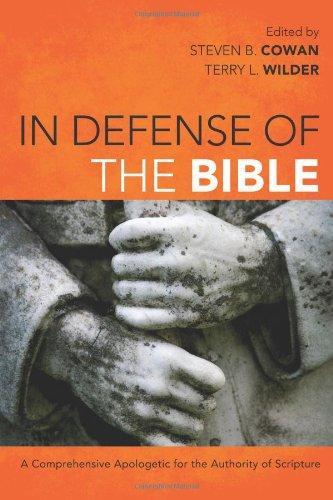Steven B. Cowan & Terry L. Wilder, (eds.) In Defense of the Bible: A Comprehensive Apologetic for the Authority of Scripture. B&H Academic, 2013. 490 pp. UD$34.99.

If you said that they’re all “things people buy and often never end up using,” then Steven Cowan and Terry Wilder’s In Defense of the Bible: A Comprehensive Apologetic for the Authority of Scripture may be the book that you need. Quite clear in its intention, this work aims to assess the Christian doctrine of the verbal, plenary inspiration – and, therefore, the inerrancy – of the Old and New Testaments by responding to many of the key criticisms levied against the Bible today. While much of its material will likely be familiar to a seminary graduate, this book offers a valuable collection of resources for the educated Christian (with plenty of footnotes to direct further study) in a single, concise volume.
The first of the book’s three sections addresses philosophical and methodological approaches to the Bible. These four chapters lay a solid foundation for what follows by addressing questions of the nature of truth and the technical aspects of literary criticism. Douglas Geivett kicks the collection off with a dialog (in the tradition of Plato, Berkeley, and Hume) that tries to ponder the likelihood of God communicating with His creation. While the points made in the chapter are generally solid, the fictionalized conversation unfortunately comes off as artificial. In fact, this was the most difficult chapter of all seventeen to finish, but that was purely a matter of its form, not its content.
Fortunately, Douglas Blount’s excellent chapter follows quickly and considers different definitions of truth and how they relate to the Bible. Unsurprisingly, he champions the correspondence theory over and above coherentist or pragmatistic viewpoints, but does a nice job explaining all three (51). However, most impressively, Blount addresses an all-too-often forgotten element of apologetics: the need for the subjective appropriation of an argument’s conclusion. It is not enough to simply prove something to correspond to objective reality, but an individual must recognize how the “excellence” of the proposition “measures up” to their own lives and “merits trust and submission” (54). Furthermore, Richard Melick, Jr., picks up on some similar concerns (after a nice chapter from Charles Quarles that defends the proper use of higher criticism) by considering how different people and schools of thought have tried to interpret the Bible in different directions. This historical overview of the interplay between the text, the authors, and the audiences culminates in the quite sensible recognition that, whereas not just any response can be considered valid, the reader’s response to the text is still an important part of the conversation (115).
Section Two of In Defense of the Bible dives into the science of textual criticism, often considering the Old and New Testaments separately for the unique works that they are. After Paul Wegner and Daniel Wallace present the data for the origination and faithful transmission of the two halves of our Bible, Walter Kaiser, Jr., and Paul Barnett tackle the question of each halves’ historical reliability. Wegner’s comparisons of the Old Testament with other ostensibly historical documents (like the Qu’ran and the Book of Mormon) and Wallace’s treatment of several popular attacks from critics like Bart Ehrman were both excellently done (especially Wallace’s, which clears up an often-repeated mistake among Christian apologists about textual variants (144) and should be required post-Ehrmanic reading). Kaiser and Barnett’s chapters are heavier on the content, though admittedly more difficult to read; Kaiser’s amounts to a dry listing of archaeological finds that confirm Old Testament claims, while Barnett’s eight-fold thought process, though clearly aiming for comprehensiveness, borders sometimes on the tedious.
This section also has a decent (though overly technical) chapter from Terry Wilder, one of the book’s editors, on the question of biblical forgeries that seeks to cast standard methods of authorship in the ancient world into their proper historical context. For someone with this specific question, the chapter would likely be beneficial, though many casual readers might find themselves skipping this portion. Mary Jo Sharp’s chapter, on the other hand, hits a solid home-run by easily squashing the far-too-popular thesis (particularly on the internet) that the Jesus story was simply a rehashing of pre-existing pagan myths; by relying on a C.S. Lewis-esque understanding of Myth (189), Sharp looks at several so-called parallels to reveal once again how empty this long-disproved hypothesis actually is. Finally, Section Two finishes with a strong showing from Douglas Huffman that lays out several key rules for interpretation, then applies those rules to eight different pieces of the Resurrection narratives to address the question of whether the Bible harbors internal contradictions. In his very methodical way (which refreshingly and continually clarifies his terminology), Huffman makes a solid case that God’s superintention of the writing of Scripture has preserved a coherent and accurate account of history (293).

The two weakest chapters of Section Three come from James Hamilton on the topic of slavery and gender roles, and from Craig Blaising on the matter of conflicting theologies between different biblical writers. Much like Flannagan, Copan, and Wilder, Hamilton does a nice job of placing the Bible’s treatment of slavery in its proper historical context, but his presentation of a complementarian reading of biblical gender roles – even if it were correct – comes off as far too tactless to be fruitful for either apologetic or evangelistic conversations. Although Hamilton tries to distinguish between sexism and submission, he does little more than quote passages and move on without clarifying just how one is not the other (although he does bluntly assert his correctness several times). Even another five hundred words in this section of his contribution would have made this chapter (the shortest in the book) far stronger. Similarly, Blaising’s chapter sounds repetitive after reading Quarles’, Melick’s, and Huffman’s. His treatment of the cohesiveness of the biblical message is a nice summary of the concepts, but if you have already read the other three chapters, then it doesn’t offer much more to the conversation beyond a few additional examples.
The book finishes strongly with a historical overview of the biblical canon courtesy of Paul Wegner (along with Wilder and Darrell Bock) that offers as succinct and comprehensive of a treatment of the history of the Bible’s sixty-six books as one can hope to find. In particular, its handling of extrabiblical gospels is quite informative for someone unfamiliar with the situation. Finally, Steven Cowan’s own contribution to the work finishes up the work by summarizing the preceding sixteen chapters into a wonderfully Christocentric argument for the divine inspiration of the Bible that offers not only a clever point about Jesus’ implied prediction of the New Testament canon (460), but also acts as a very satisfying conclusion to the entire book.
While it would significantly benefit from a more detailed subject index in a second printing, In Defense of the Bible is a fine work that addresses many of the most common questions that a Christian might feasibly face on this topic. Much like Groothuis’ Christian Apologetics is for apologetics or Moreland and Craig’s Philosophical Foundations for a Christian Worldview is for philosophy, In Defense of the Bible has the potential to become the go-to introductory reference work for evangelical Christians on the subject of Scripture.
photo credit: notashamed via photopin cc
Tags: Apologetics, Bible, Book Review, Christian Apologetics, Christianity, Historical Reliability, Textual Criticism